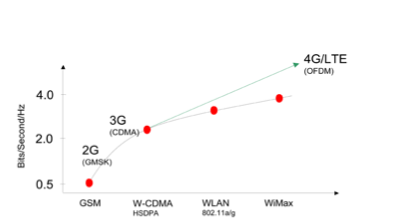Orthogonal frequency division multiplexing (OFDM) is a form of digital modulation used in a wide array of communications systems. This paper will explain what OFDM is, why it’s important, where it’s used, and what test instrumentation is required to maintain it.
Perhaps we should first explain what is so special about OFDM. Three things stand out. OFDM is spectrally efficient, carrying more data per unit of bandwidth than such services as GSM and W-CDMA. Figure 1 shows a comparison of the spectral efficiency of the leading cellular technologies and how they compare to WLAN and WiMAX. Fourth Generation technology, often referred to as the Long Term Evolution of wireless (LTE) and Ultra Mobile Broadband (UMB) for cellular devices, plans to use OFDM or OFDMA.

Figure 1. The spectral efficiency of the leading cellular technologies and how they compare to WLAN and WiMAX. Fourth Generation technology, often referred to as LTE, or the Long Term Evolution of wireless for cellular devices, will use OFDM.
OFDM tolerates environments with high RF interference. Some services that use OFDM — such as WLAN — operate in the unregulated ISM (Industrial Scientific Medical) bands, where they must co-exist with many unregulated devices, including analog cordless phones (900MHz), microwave ovens (2.45GHz), Bluetooth devices (2.45GHz), digital cordless phones (2.45GHz or 5.8GHz) and Wireless LAN (2.45GHz or 5.8GHz).
Finally, OFDM works well in harsh multi-path environments, as we shall see.
| PDF 1.2 Mb |
| |
|
| ||
